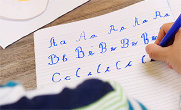Buying tech for kids? Here’s what you need to know
Pencils, exercise books and lunchboxes – that part of back-to-school shopping is relatively easy. But what about devices? With BYOD (bring your own device) a key part of the school landscape, tech is an essential item on the list this year.
But with so many options on the market, it can be hard to know what your children need. That’s why we’ve asked trusted technology journalist and tech expert Trevor Long for his tips on buying tech tools.
First things first – tech basics
Schools may have different tech requirements, so it’s important to check your school’s BYOD policy before you start shopping. This policy should outline minimum requirements for devices, such as brands or models, minimum specs for processors (CPU) and storage (hard drive), preferred operating systems and any Wi-Fi network specifications. If in doubt, check with your child’s teacher.
According to Long, Windows 10 is most popular operating system in Australian schools, and some school programs may not work as effectively on Apple’s OS X operating system. Make sure you confirm your school’s preferred operating system before you start shopping.
Sturdy build quality and battery life are also important considerations when shopping for kid-friendly tech. Look for products that offer at least 8 hours of battery life, and that can survive a tumble in a schoolbag.
Trevor’s tip: Many parents are pressured by children to buy a certain device over another, so talk to the school first.
What’s on the market?
While we’re most familiar with laptops or notebooks, there are many other school-friendly devices on the market today.
- Chromebooks are similar to a laptop, but only run the Chrome operating system (not Windows). While there are some Chrome OS apps, Chromebooks are best suited to be used with a constant internet connection.
- MacBooks are Apple laptops that run the OS X operating system. However, they can be configured to run Windows as an optional extra.
- Ultraportables are thin and light laptops. While small in size, they can still pack a punch when it comes to power.
- Convertibles (also called or 2-in-1s or hybrids) are a combination of laptop and tablet. They bring together the features of a traditional laptop with a tablet screen that can be folded back or detached from the keyboard.
- Tablets are wireless devices with a touchscreen interface. They’re available across a range of operating systems, including Android (Samsung Galaxy Tab and Lenovo), Windows (Microsoft Surface and Dell) or Apple iOS (iPad).
Trevor’s tip: Primary education systems are investing heavily in future connectivity. The days of the tech-free primary classroom are numbered.

Check the Wi-Fi specs of any device to be sure it’s compatible with both home and school networks.
Laptop, tablet or convertible?
Young children don’t need a powerful device, so a tablet or iPad is a great choice for primary school-aged kids. However, as they get older, laptops or convertibles with higher processor speeds and in-built keyboards will be the smarter option.
For middle years (7-9), Long says Chromebooks are a good option. They can’t compete with the better laptops on the market, but they’re not designed to. With functionality limited to running the Chrome browser and Chrome OS apps, they offer speed and simplicity.
From Year 9 onwards, base your buying decisions on power and speed. Convertibles offer the best of both worlds, combining elements of a laptop and tablet into one, while traditional laptops offer the security of faster speeds, greater software options and sturdiness.
Trevor’s tip: The best option for secondary school might be a convertible that suits moderate use both in the classroom and at home.
Don’t skimp on memory
When choosing a model, the more memory (RAM) the better. Your school’s policy will provide a guide for minimum requirements, but if in doubt, err on the side of ‘more is more’.
Trevor’s tip: Investing in a faster processor and more RAM at the outset will pay dividends.
Protect your investment
Even the sturdiest tech devices need protection. Carry your laptop or tablet inside a simple sleeve so it’s protected from basic drops and knocks.
Consider some form of extended support like Apple Care, where you can have the assurance of ongoing assistance. Officeworks offers Extra Cover Plans, so if you damage a device, you can get it fixed or replaced. You just pay an excess.
If your children’s school requires them to frequently carry the device to class, you should consider some form of insurance. If they’re only using the device at home, make sure it’s covered under your home and contents policy.
Label your devices
No one likes losing things. And if your kids are in a class full of students with identical devices, this will be a real risk. A simple label maker can help identify devices – and keep them safe. Consider including a mobile phone number on the label, so that if the device is found beyond the school grounds, it will be easy to return.
There are also lots of fun ways for kids to personalise their tech. This video features a creative solution to labelling.
Ready to find the perfect device? Get shopping with our easy to use back-to-school tech selector.


 has the facebook
has the facebook




